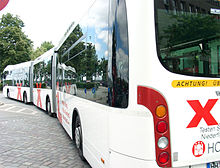Articulated vehicle
![]()
This article is not sufficiently supported by evidence (e.g., anecdotal evidence). Information without sufficient evidence may be removed soon. Please help Wikipedia by researching the information and adding good evidence.
So far, there are no sources given at all. --DF5GO 21:34, 13 Oct 2012 (CEST)
Articulated vehicle or articulated vehicle are vehicles which consist of several articulated parts which cannot be separated operationally, whereby passage through the articulation is possible during travel. Typically, a turntable is provided in the area of the articulation for this purpose, which necessarily adjusts itself in such a way that the angles between the longitudinal axis of the two vehicle parts and the longitudinal axis of the turntable are both always the same. The outer skin in the area of the joint must be able to deform elastically and is therefore normally designed as a bellows. In order to improve the brightness inside the vehicle, transparent bellows are being tested.
Joints are provided in order to make vehicles more capable of cornering or tilting without having to disassemble them into several separate parts. If it is only a question of cornering capability, a swivel joint that is rigid in the vertical direction is sufficient; in practice, the two vehicle parts usually also have to be able to raise and lower ("pitch") against each other. The joint construction itself for bus joints classically consists of two approximately triangular components, which are mounted (partly rubber-elastic) on the two vehicle parts and are connected in the middle by the actual joint. They are connected to each other by articulated dampers. A distinction is made between "pusher" and "puller" articulations; in the former the front carriage is pushed by the driven rear carriage, in the latter the rear carriage is pulled by the front carriage. The conventional length of an articulated joint is about 1.6 m; a short pusher joint is currently being developed which operates on a completely different principle with two crossed traverses articulated movably on both sides and is about 60 cm shorter, which corresponds to an additional row of seats in a normal city bus.
Many buses (especially city buses, more recently also intercity buses) are articulated buses, as are numerous trolleybuses designed as articulated trolleybuses. Likewise, modern light rail and also mainline railcars are almost always articulated. Buses and trolleybuses usually have one, in rare exceptional cases two, articulated joints, while mainline railcars and light rail units often have many more joints (up to six), the latter in order to be able to meander through the tight curves, crests and depressions on tram lines, for example in old towns.
Not to be confused with articulated vehicles are rail vehicles that consist of several close-coupled units (e.g. S-Bahn railcars of the 420 series). Here, operational separation of the individual wagons is possible.
There are a number of articulated cars without drives in rail transport; most of them are freight cars, but there have also been articulated dining cars and, on trams, articulated sidecars.
The definition of articulated vehicle can be found in the Austrian law §2 KFG Z13.

Van Hool double articulated bus (length 24.80 m)
See also
- Articulated wagon (tram)
Search within the encyclopedia